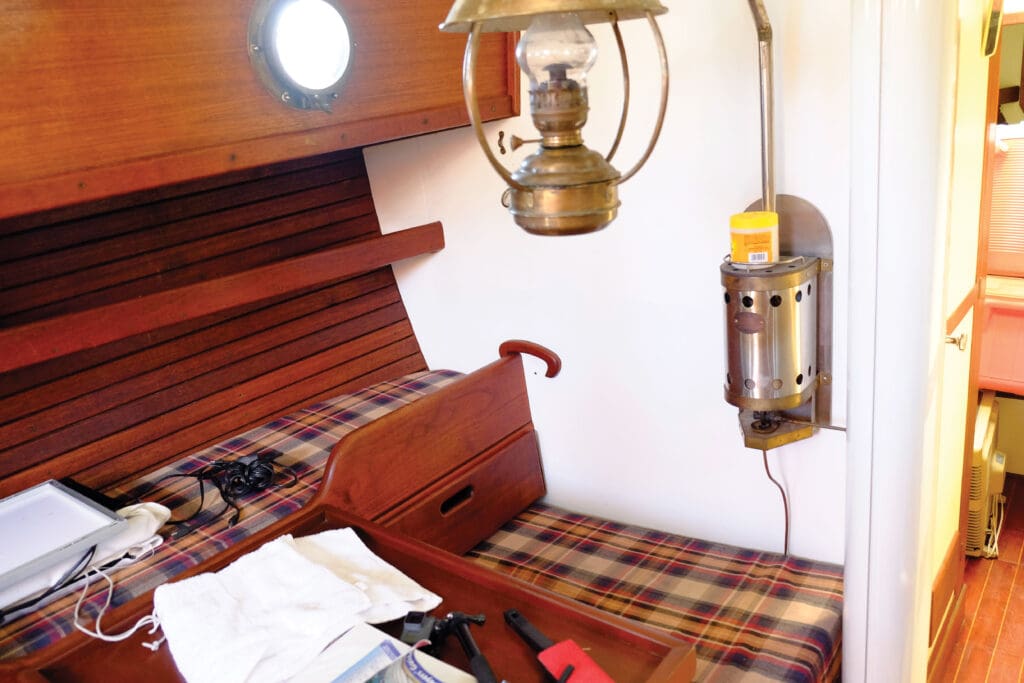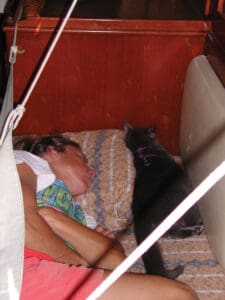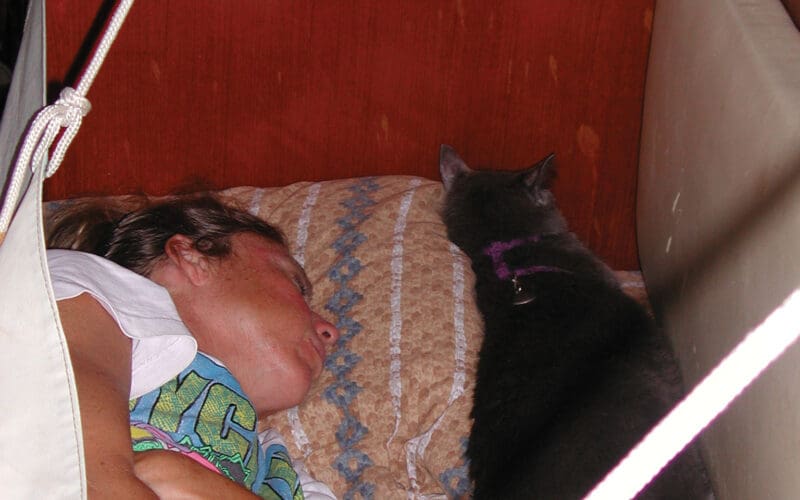
Life at sea is lived 24 hours a day, whether you are a cruising single-hander or a navy destroyer sailor. By this I mean there’s no period in which humans can ignore input from the outside world and just sleep.
How do we balance the fundamental need for sleep with the requirement to be vigilant, and what are the consequences of being unbalanced? There’s surprisingly little research on those who live and work at sea, but studies of the effects of sleep deprivation by sleep labs on land are useful.
In an effort to find balance, vessels set up watch systems, or schedules. The term “watch” refers to a time interval, not to actively “watching.” Watch systems account for sleep time and waking/work time; though the 24 hours in a day offer a variety of possible schedules, in practice, just a few have ended up being adopted.

Sleep Deprivation
The Cleveland Clinic defines sleep deprivation as “when you aren’t sleeping enough, or you aren’t getting good, quality sleep,” and adds that when severe, or long-term, it causes “disruptive” symptoms that interfere with routine activities and cause or aggravate health conditions.
Aboard a long-distance cruising boat, sleep deprivation can occur when (a) crew members don’t get adequate sleep on their watch schedule or (b) a situation occurs that requires they stay awake beyond the reasonable interval of wakefulness, as in an all-hands-on-deck emergency. Experts agree that by 24 hours, signs of impairment show up that are similar to being drunk.
Only once in my years of offshore cruising did I reach the 24-hour mark, and that was on passage from Georgetown, Bahamas, to Newport, R.I. Tom and I had traveled a day north on our Peterson 44 Oddly Enough when we encountered a solid line of thunderstorms. When I headed into what appeared to be a gap, the clouds descended rapidly. I turned back toward a glimpse of sky, and when we popped out, we called Herb on Southbound II on the radio weather net, who said a thunderstorm system stretched across the Atlantic, and we’d do better by returning to Georgetown than attempting to sail the 200 miles around.
This was to be our first open ocean voyage, and as captain I didn’t feel comfortable leaving the helm for the trip back. I remember by the next morning just wanting to sleep so I could turn off my brain and not have to deal with the situation anymore. At the end of the long night, we successfully negotiated a non-recommended entry in worsening weather through the reef, and I think the need for fierce concentration is what saved me. But on an average voyage, this kind of sleep deprivation is less common than the day-to-day kind.
The U.S. Navy employs two watch schedules: 5/10 and 3/9. The 5/10, five hours of sleep and 10 hours awake, sets up a rolling watch schedule of 25 hours so each sailor’s rest time shifts by an hour a day. The idea behind this is no one is always stuck with the midnight watch. Three and 9 means two full watch schedules within one 24-hour period. In a controlled study, the Navy found 3/9 was less disruptive because its consistency better supported psychomotor vigilance, the ability to sustain attention in a stable manner across watch days. Sailors got less than ideal sleep time, but at the same hour each day. Because maintaining a vessel and being alert for problems require vigilance, any schedule that leads to poor performance is potentially dangerous.
Rotating watch schedules run counter to what’s called the circadian rhythm, defined as the physical, mental and behavioral changes an organism experiences over a 24-hour cycle. Light and dark affect this, as do food intake, stress, physical activity, social environment, temperature and work schedules. Your body attempts to align your sleep/wake cycle to cues from the environment, and if it can’t, you may have difficulty sleeping, and the quality of your sleep may be poor. Research shows that shift workers who work at night and sleep during the day often suffer from sleep deprivation even if they get a full seven or eight hours of sleep.
When Tom and I sail overnight, we stick to three-hour watches, beginning at 2000, 2300, 0200 and 0500, and we always take the same watch. I stand 2000 to 2300 and get the boat stable on her nighttime course. Tom finishes up the schedule with the 0500 to 0800 watch and experiences the dawn, which I saw only occasionally when we were in the tropics and then only if we were out of sync because of emergency or urgency.
When I wake from my watch, we eat breakfast together and spend the day in unstructured time, much as we would on land. Jimmy Cornell, in his book, World Cruising Survey, listed the three-on, three–off schedule as the most common on boats with two or three crew members, and most boats with fixed schedules keep them only at night.
Studies show adults need at least seven hours of sleep in a 24-hour time frame. Ideally, this would be taken in one go, but research also shows that sleep cycles are made up of periods of sleep—light, deep, deeper, and REM—and a sleeper rotates through them four or five times in a normal night, with each full cycle lasting 90 to 120 minutes. This means a sailor on a three-hour down watch could theoretically go through two full cycles.
Tom and I find single overnight sails the hardest. Even though we keep our normal watch schedule, we don’t sleep as well. On longer trips, I fall asleep quickly when I lie down in the sea berth at 2300, and when Tom wakes me at the end of three hours, I’m instantly awake. I get as full a cycle as I can, and I suspect, without confirmation from the literature, that my body has learned to compress the cycle. I do know that for years after we returned from 10 years’ offshore cruising, I was unable to recall dreaming, and it’s only recently that some of that awareness has come back.
Of course, simply setting a watch schedule is not enough if you don’t also design a good physical sleeping arrangement. The body needs to be prevented from moving with the rolling and pitching of the boat. Otherwise, trying to brace yourself will keep you awake or wake you up if you do get to sleep. At night on Oddly Enough, we slept in the starboard salon settee with a lee cloth tied to handrails overhead. It wasn’t so snug as to keep me from turning over, but I rolled with the boat’s movement without having to brace and could lean into either the cloth or the back cushion on a heel.
What are the effects of sleep deprivation, and what are its potential consequences? An article in the International Journal of Environmental Research and Public Health assessed the “risk of sleep deprivation–related sleepiness during navigation and the factors contributing to this risk.” Navigation is the work of determining a ship’s position, deciding which course to follow to a destination and steering it there. Forty percent of the study’s participants (French maritime officers) experienced occasional severe sleepiness, and 29 percent had fallen asleep during navigation. Along with managing ship navigation, maritime officers must keep a constant watch on the maritime environment, be able to apply navigation rules to any encounter, monitor the condition of the ship and react to damage or risk of collision.
“Sleepiness is the desire to fall asleep,” says Brandon Peters, a neurologist specializing in sleep disorders. It may be the most common effect of offshore watch-keeping. Usually, a boat on the high seas does not encounter exciting or life-threatening situations that grab one’s attention. Rather, it goes through long, dark hours of sameness, which can induce a loss of attention.
On Oddly Enough, we had book lights and Kindles to occupy our minds; we also had a roomy cockpit dodger, which protected us from wind and weather. We could make hot beverages with caffeine though it might have disrupted our next sleep period, and we kept a locker of easy-to-reach snack items. And because we know human foibles, we could set a timer to look over the rails at intervals, and we were supposed to note our course and weather conditions in the logbook below. We used red light, of course, because anything that disrupted the off-watch person would only hurt ourselves.
The Bridge Navigational Watch and Alarm System (BNWAS), an electronic system used on ships that aims to prevent the officer from falling asleep or fainting during watch, triggers an alarm at regular intervals that the officer must turn off. Unfortunately, it appears this system is frequently deactivated by many officers.
Sleepiness turns worrisome incidents into full-blown emergencies. For example, a boat approaching could be turned away by an alert sailor or become a collision if unnoticed. Without enough sleep, processes throughout the body work sub-optimally. Neurons in the brain become overworked, impairing thinking, slowing physical reactions and leaving people feeling emotionally drained. An article in Fisher Scientific’s Lab Reporter cites the National Sleep Foundation as saying sleep deprivation increases the likelihood of a workplace accident by 70 percent.
The American Safety Council lists these dangers for tired workers:
•Improper safety enforcement and exposure to major injury
•Impaired motor skills
•Risk-taking and poor decision-making
•Poor memory and information processing
•Inability to deal with stress
•Falling asleep on the job
A worker who falls asleep on the job will not react to a potential hazard in a timely manner. In the 1989 Exxon Valdez disaster off the coast of Alaska, the third mate steering the supertanker decided to take a cat nap following a 22-hour shift. Literally asleep at the wheel, he was unable to prevent a crash that spilled over 250,000 barrels of crude oil into Prince William Sound.
Our year’s “class” of about 100 South Pacific crossing sailboats experienced at least 11 total boat losses: some complete wrecks, some disappearances, some resulting in death. All the sailors were experienced enough to have made it at least partway across the Pacific, but one accident has always haunted me.
A family sailing at night along the coast of an island wrecked their boat when the captain, an experienced multi-year cruiser, made an error in his navigation and instead of turning into harbor, turned too soon and smacked the boat into the side of the island. All were rescued, but the boat was a total loss.
Fatigue
Fatigue, also a possible result of sleep deprivation, is a feeling of constant tiredness, burn-out or lack of energy and affects one’s capacity to perform adequately or appropriately. In a recent example from the 2023-2024 Global Solo Challenge race, Pavlin Nadvorni, already suffering from the stress of trying to find a sheltered place at the south end of New Zealand to repair detached mainsail track sections, had to anchor under sail after a line wrapped around his prop. He dove to free it, but in his sleep-deprived condition, he didn’t realize his tank was leaking until he ran out of air before he could free the line.
Both short-handed and single-handed sailors benefit from reefing sails at night, heaving to if there’s any doubt or to get some sleep. For short-handers like us, going to a two-hour watch system when conditions are difficult is better because one’s capacity to deal with stress is diminished. ν
Ann Hoffner has been a sailor since she was nine years old. She learned on dinghies and small keel boats but her first voyage on a “big” boat BVIs charter showed sailing could be a way of life. She’s lived, taught, raced, worked and crossed oceans on boats much of her adult life and for the last 20 years has written about her adventures. Along with Tom Bailey, husband and photographer, they downsized from their Peterson 44 Oddly Enough to Ora Kali, a nimble, shoal draft Sabre 30 that is teaching them the joys of Maine Coast cruising.

